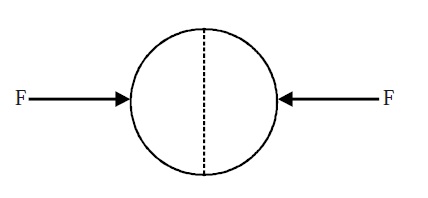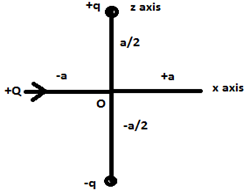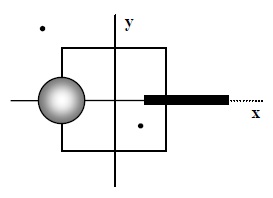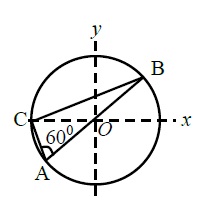Electric Charges and Fields - Online Test
Q1. A particle of mass m and charge q is released from rest in a uniform electric field E. The kinetic energy attained by the particle after moving a distance x is
Answer : Option A
Explaination / Solution:
If a charge q moving in electric field F=qE, displacement=x W=Force X displacement W=qE x=Kinetic energy
Q2. 
A uniformly charged thin spherical shell of radius R carries uniform surface charge density of σ per unit area. It is made of two hemispherical shells, held together by pressing them with force F(See figure). F is proportional to

Answer : Option C
Explaination / Solution:
Outward electric field at the surface of shell is If Q is the charge on the shell and A is the area, than the outward pressure is Force=PX effective area of hemispherical shellSo
Q3. Two charges A = -2.50 μC and B = 6.0 μC are at a distance of 1 meter from each other. Distance from A at which the electric field is zero in meters is
Answer : Option B
Explaination / Solution:
where x= distance of null point from small charge, d=distance between two charges, q2=bigger charge, q1=small charge, +1 for like charges and -1 for unlike charges
Q4. A long, hollow conducting cylinder is kept coaxially inside another long, hollow conducting cylinder of larger radius. Both the cylinders are initially electrically neutral.
Answer : Option A
Explaination / Solution:
When the charge is given to inner cylinder than there is an electric field is produced between cylinders which is given byand due to this a potential difference is developed between two cylinders.
Q5. Consider a neutral conducting sphere. A positive point charge is placed outside the sphere. The net charge on the sphere is then,
Answer : Option A
Explaination / Solution:
If a charge q is placed outside than the electric field lines incident on the conducting sphere , if some charge is developed due to thee lines than opposite surface becomes oppositely charge and the total charge becomes zero.
Q6. Positive and negative point charges of equal magnitude are kept at ( 0,0,a/2) and (0,0,-a/2) respectively. The work done by the electric field when another positive point charge is moved from (-a,0,0) to (0,a,0) is
Answer : Option A
Explaination / Solution:

+Q charge is moving on equatorial line of dipole as shown in figure, since on equatorial line V=0 So W=0

+Q charge is moving on equatorial line of dipole as shown in figure, since on equatorial line V=0 So W=0
Q7. A disk of radius a/4 having a uniformly distributed charge 6C is placed in the x-y plane with its centre at (−a/2, 0, 0). A rod of length a carrying a uniformly distributed charge 8C is placed on the x-axis from x = a/4 to x = 5a/4. Two point charges −7C and 3C are placed at (a/4, −a/4, 0) and (−3a/4, 3a/4, 0), respectively. Consider a cubical surface formed by six surfaces . The electric flux through this cubical surface is


Answer : Option C
Explaination / Solution:
Electric flux through a surface is given by Where q= net charge enclosed inside the surface Since half the disc lies inside the surface and one fourth of rod lies inside the surface, point charge lies inside the surface and point charge 3C lies outside the surface So the net charge enclosed by the surface is So
Q8. Under the influence of the coulomb field of charge +Q, a charge −q is moving around it in an elliptical orbit. Find out the correct statement(s).
Answer : Option A
Explaination / Solution:
Since the charge –q is moving in elliptical orbit so to make its motion stable the total angular momentum of the charge is constant since it experience a centripetal force from the charge +Q so it follow the motion as the motion of earth around sun.
Q9. Consider a system of three charges placed at points A, B and C, respectively, as shown in the figure. Take O to be the centre of the circle of radius R and angle CAB =


Answer : Option C
Explaination / Solution:
The electric field due to charges at A and B are equal and opposite, So at O the electric field is due to C only, which has a magnitude The potential energy of the system is not zero Force between B and C
Q10. An oil drop of 12 excess electrons is held stationary under a constant electric field of in Millikan’s oil drop experiment. The density of the oil is 1.26 g cm-3. Estimate the radius of the drop. (g = 9.81 m ; e = 1.60 × 10-19 C).
Answer : Option D
Explaination / Solution:
Density of oil, ρ = 1.26 gm/ = 1.26 × kg/ Acceleration due to gravity, g = 9.81 m Charge on an electron, e = 1.6 × C Radius of the oil drop = r Force (F) due to electric field E is equal to the weight of the oil drop (W) F = W Eq = mg Ene=mg Where,q = Net charge on the oil drop = ne m = Mass of the oil drop= Volume of the oil drop × Density of oil So 2.55×(12×1.6×)= 1.26X × So r = 9.82 × mm Therefore, the radius of the oil drop is 9.82 × mm.
